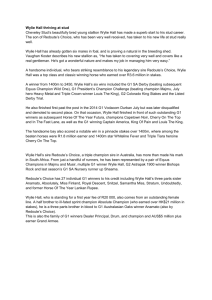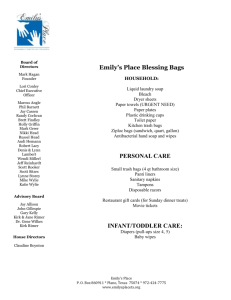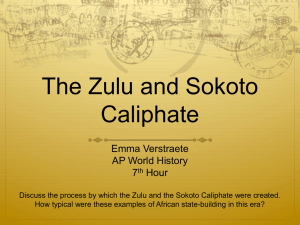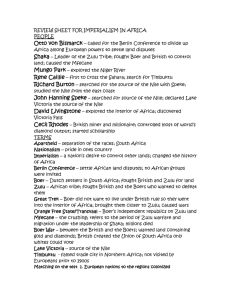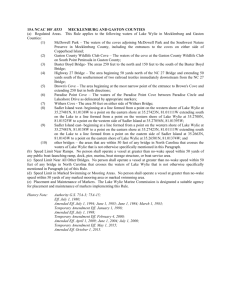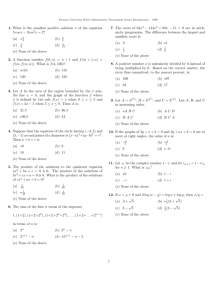Myth (De)Constructed: Some Reflections Provoked by Dan Wylie's
advertisement
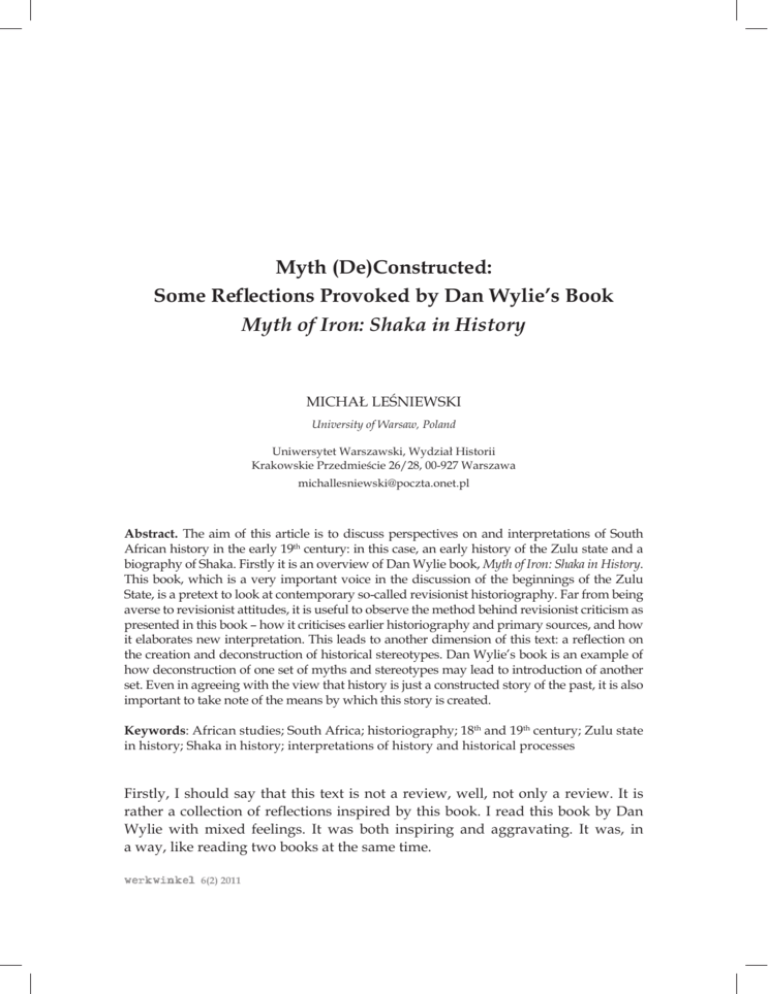
Myth (De)Constructed: Some Reflections Provoked by Dan Wylie’s Book... 55 Myth (De)Constructed: Some Reflections Provoked by Dan Wylie’s Book Myth of Iron: Shaka in History MICHAŁ LEŚNIEWSKI University of Warsaw, Poland Uniwersytet Warszawski, Wydział Historii Krakowskie Przedmieście 26/28, 00-927 Warszawa michallesniewski@poczta.onet.pl Abstract. The aim of this article is to discuss perspectives on and interpretations of South African history in the early 19th century: in this case, an early history of the Zulu state and a biography of Shaka. Firstly it is an overview of Dan Wylie book, Myth of Iron: Shaka in History. This book, which is a very important voice in the discussion of the beginnings of the Zulu State, is a pretext to look at contemporary so-called revisionist historiography. Far from being averse to revisionist attitudes, it is useful to observe the method behind revisionist criticism as presented in this book – how it criticises earlier historiography and primary sources, and how it elaborates new interpretation. This leads to another dimension of this text: a reflection on the creation and deconstruction of historical stereotypes. Dan Wylie’s book is an example of how deconstruction of one set of myths and stereotypes may lead to introduction of another set. Even in agreeing with the view that history is just a constructed story of the past, it is also important to take note of the means by which this story is created. Keywords: African studies; South Africa; historiography; 18th and 19th century; Zulu state in history; Shaka in history; interpretations of history and historical processes Firstly, I should say that this text is not a review, well, not only a review. It is rather a collection of reflections inspired by this book. I read this book by Dan Wylie with mixed feelings. It was both inspiring and aggravating. It was, in a way, like reading two books at the same time. werkwinkel 6(2) 2011 56 Michał Leśniewski If one were to ask me if this is a good monograph, I would not be able to give a decisive answer. There are two different dimensions to this book: one is the discussion of Shaka’s biography, the second is a jaunt into the debate on the factors surrounding Shaka’s life, the construction of the Zulu state and, in broader perspective, that of other states of this region during the first decades of the 19th century. Both dimensions are interconnected on several levels. This book is not only an analysis of Shaka’s career, but also of the socio-political evolution of the whole region of Natal-Zululand, with some excursions into the High Veld and southern Mozambique. Therefore the author obviously not only discusses various historical accounts about Shaka in detail, but also takes part in the historiographical debate concerning the motivating factors and forces behind the emergence of the Zulu state, and the so called mfecane/difaqane. Why then divide these two aspects of this book? Because these two dimensions should be evaluated separately, however closely they are connected. Dan Wylie is renowned as an author specialising in the portrayal of Shaka in historiography. Several of his publications concern this topic (Wylie 1992, 1995 a and b, 2001), therefore he is well qualified to write such a book. But how does one define this book? One of the most important notions the author raises is: “it’s scarcely possible to write a biography of Shaka at all” (Wylie 2006: 3). This statement may seem somewhat awkward, not only because biographies of Shaka have been published (Ritter 1955; Cohen 1973; Kunene 1979), although most of them are more popular than scholarly, and in fact the very book by Wylie can be considered a rather voluminous biography of the creator of the Zulu state (Redding 2007: 162). The fact that the author himself calls it an “anti-biography” (Wylie 2006: 3) does not change much in this respect. Authors’ statements about their own work are often misleading. In this case we are getting a voluminous book which is to a great extent a reconstruction of Shaka’s life and times. Therefore why not call it a biography? As the author stresses himself, the main reason for writing this book was to deal with deeply-rooted stereotypes concerning Shaka, one of the best known personalities in South African history. He promised to show that the biographies and other accounts of Shaka’s life and deeds should best be seen as pseudobiographical accounts based mostly on a set of myths and misjudgements, which tell us a lot about their authors and very little about Shaka himself. At the same time he promised to deal with certain myths concerning the origins of the Zulu state and the effects of its rise. Other texts, by Julian Cobbing, 1 Carolyn Hamilton and John Wright (see: Cobbing 1988a; Hamilton 1995, 1998; Wright, 1989, 1995, 2006-2007), deal with these topics, but this book is surely the most voluminous one. Dan Wylie acknowledges his debt toward Julian Cobbing and his ideas and concepts, which permeate his whole book. See: Wylie (2006: XVII, 66, 437-439). 1 6(2) 2011 werkwinkel Myth (De)Constructed: Some Reflections Provoked by Dan Wylie’s Book... 57 Dan Wylie goes meticulously through a large number of primary sources and accounts. Starting from the collected oral histories of Zulu speakers contained in the James Stuart Archives (Webb and Wright 1976-2001), he progresses through the numerous memoirs written by white adventurers, traders, missionaries and officials living in South Africa at that time, who had personal contact with Shaka or who knew of him indirectly. This study leads him to the conclusion that there are very few undisputed facts about Shaka’s personal life and actions. Firstly, we do not know when Shaka was born. There are several statements concerning his date of birth, and as Wylie points out, non of these are undisputable (Wylie 2006: 100-102). We know very little about Shaka’ s childhood. We know virtually nothing about Shaka’s career under his mentor Dingiswayo. Wylie stresses that even the most widely acknowledged date of Shaka’s ascension to the throne could be disputed, and moved back a few years (Wylie 2006: 149). We have very little insight into Shaka’s character, and the reports that we do have often contradict others. Therefore, Wylie states that: “the material for a trustworthy ‘biography’ of Shaka simply does not exist” (Wylie 2006: 481). To a large extent, it is difficult not to agree with him. In fact, the moments when he does try to reconstruct certain facts are even more convincing as proof that such reconstruction is nearly impossible. When he moves Shaka’s birth date a few years back, to 1781, he is just calculating a median out of available accounts (Wylie 2006: 100-102). Similarly, when he moves the date of Shaka’s ascension to the Zulu throne back to 1812, he is not following any primary sources, which point to 1816 (Stuart and Malcolm 1986: 13) or 1817 (Webb and Wright 1982: 94), but rather calculating and reasoning. The dates proposed by Wylie do not seem to be more correct than those put forward by Holden, King, Bryant or native informers, even in the more convincing case of Shaka’s ascension. In fact this very ambiguity is the most important implication of Wylie’s calculations. They and the reasoning behind them seem to be logical enough to accept as possible and plausible alternatives. In fact he shows that all dates before 1824, when British traders settled in Port Natal (IsiBubulungu), should be treated as nothing more than estimations. Even some later dates, statements and descriptions are, according to Wylie, questionable, despite the fact that written sources are available. The contradictory nature of these documents and accounts give reason to his thesis that writing a true Shaka biography is not possible. His sizable book proves how little could be confirmed. Therefore, despite the fact that his text may look like a comprehensive biography (Redding 2007: 163), it is not. Yet there is another side to the reasonable doubt surrounding (re)constructions of the chronology of Shaka’s life. It is not important whether Wylie is right or werkwinkel 6(2) 2011 58 Michał Leśniewski wrong in his calculations or whether they are in any way more correct than traditional methods. More important is the fact that he questions the credibility of the primary sources. He tries to show that they are biased and they represent the settler, or more broadly the European point of view, and therefore they could not be properly verified. He points to the fact that the three most important settler sources are in fact not original. We know that The Diary of Henry Francis Fynn was published in its final form from various papers which were reworked, edited, and possibly rewritten from original material by James Stuart (Waliński 1996: 13; Wylie 2006: 7). In the case of Nathaniel Isaacs’ Travels and Adventures in Eastern Africa (1836), it is quite possible, taking into account his limited literacy (Wylie 2006: 7), that the published version was strongly edited, or even ghost-written. The author suggests that we do not know if there was any original Isaacs diary. This is very possible, but the fact that some fragments of his narrative were published in 1832, in the “South African Commercial Advertiser” should make us a bit cautious about such statements (Isaacs 1832; Waliński 1996: 16). Finally, there are memoirs by Charles R. Maclean known as The Natal Papers of ‘John Ross’ (Maclean 1992), which are highly valued by Wylie (Wylie 2006: 8), but the value of even this account is somewhat downplayed by the fact that it was never completed, and was written in retrospective twenty years after the fact (Maclean 1992: 1, 22-30). One can rightfully ask why he highlights these three sources. These are not the only European sources on Shaka’s life. He does not mention, for example, a compilation of documents and narratives published by John C. Chase in 1843, just fifteen years after the Shaka’s death (Chase 1843; Waliński 1996: 16). He also does not mention Allen F. Gardiner’s narrative, published in 1836. This text mostly reflects the situation at the time of Dingaan’s rule. The character of Zulu society did not change that much during these seven years (Gardiner 1836). One has to agree with his assessment: the chronology in these sources is often blurred and in many places contradictory. Therefore, even this part of the chronology of Shaka’s life is somewhat dubious. What is more, Dan Wylie stresses that they are not only contradictory, but also distorted: the authors had a lot to lie about, as they led lives which were in contradiction to the standards of the time. 2 They were therefore not inclined to portray this side of their lives. This is only partially true, because although Fynn officially professed his aversion to fight for the Zulus, he still acknowledges that he was fighting in Zulu campaigns (Stuart and Malcolm 1986: 238, 249-251). Even if we accept that Wylie is for the most part right, there are still The first British settlers in Port Natal lived in polygamous unions with native wives, they were also smugglers and acted as mercenaries for local communities, for example the Zulus. It is possible they were engaged in slave trading, which was forbidden for British subjects. See: Ballard (1982: 49-54); Wylie (2006: 7-8). 2 6(2) 2011 werkwinkel Myth (De)Constructed: Some Reflections Provoked by Dan Wylie’s Book... 59 we have other sources which can aid understanding. The Zulu oral traditions collected by Stuart contain sensitive information concerning the adoption of northern Nguni social customs, among them also marriage practices (Webb and Wright 1976: 1, 111-112). Such information can also be found in other primary sources of European origin (Maclean 1992: 49, 62-69; Kay 1833: 397-402). Still, Wylie points out a genuine difficulty. The primary sources represent one side of the story. They were written by European colonists, hunters, traders, missionaries or officials, who for the most part did not understand all the social and cultural factors and conditions shaping African communities of the time, or had their own agendas. They needed justification for their conquest, for the destruction of the Zulu state, for dispossession of African communities. Even the native oral traditions, especially those collected in The James Stuart Archive, are tainted and distorted by European literary narration, settler traditions, by the James Stuart methodology, and the very fact that they are chronologically quite far removed from the times of Shaka. These narratives are mostly second-hand, mediated by the European interviewer and accommodated to the European standards of editorship and publication (Cobbing 1988a: 115-154; Wylie 2006: 5-9; Waliński 1996: 9). On the other hand, Wylie’s book itself is the proof that even such biased, one sided sources could be used to reconstruct, or rather to construct historical narrative, which at least tries to filter out the bias to give a more balanced view of the past. Even at this level of this book we are confronted with the problem which permeates all revisionist thinking about the Zulu State, Shaka, and much of the debate concerning the roots and origins of the mfecane/difaqane, and statebuilding processes in South Africa. There is a certain set of a priori assumptions. Wylie is sensitive to the bias of primary sources, to the fact that in the case of Shaka, legend has, to a great extent, replaced historical fact. The personality of Shaka seems to exist as a collection of stereotypes and constructions. The problem is that even those supposedly more reliable primary sources support the view of Shaka as a cruel and capricious person and attests to his arrogance and aggressiveness (Maclean 1992: 135, 136; Webb and Wright 1986: 4, 64-65). In fact, as James O. Gump states in his review of Wylie’s book: “The portrait of Shaka that one can patch together from Wylie’s ‘anti-biography’ is not unlike that featured in a number of scholarly accounts of the Zulu leader’s life. The evidence reveals a man who is both generous and cruel, calculating as well as capricious” (Gump 2007: 362). We should acknowledge that we should be very careful, critical and sceptical in our analysis of existing primary sources. The first commandment of any professional historian is to be critical. But in this case, one should ask whether werkwinkel 6(2) 2011 60 Michał Leśniewski we are not dealing with a priori assumption. There is a strong sense, when reading between the lines of Wylie’s book, that we are dealing with some sort of conspiracy. That we should distrust all the settler/European sources just because they are settler/European. In this respect Dan Wylie is clearly a follower of Julian Cobbing, and on par with historians such as Norman Etherington (Cobbing 1988b: 487-519; Etherington 2001: 329-346). It is possible that such texts, for example the official statements and analyses of Theophilus Shepstone, could be strongly biased, and even written with a certain thesis in mind. But taking into account the diversity of sources written during the thirties and forties of the 19th century, it is difficult to accept that each and every narrative and document was written with the same assumptions. Even if elements were edited out in some narratives (Waliński 1996: 11-12), in others they were not, as was the case with interracial marriages or slave trading (Kay 1833: 397-402). Therefore it might be asked whether Wylie’s attitude toward those sources is not biased. Presenting the history of the beginnings of the Zulu state, he presents both Shaka and the Zulu state, not as a source of social, political, and military upheaval in South-Eastern Africa, but as one of many states and chiefdoms which were created as a result of this upheaval. In this case, he follows in the steps of Prof. John Wright (Wright and Hamilton 1989: 49-82; Wright 1995: 163-181). This attitude is widely accepted by contemporary historians, even those, like John Omer-Cooper, who at one time propagated the idea that the Zulu state was at the centre of the great migrations (mfecane/difaqane) of the second and third decade of the 19th century (Omer-Cooper 1995: 277-298). Where he differs from J. Wright and steps back into the shoes of J. Cobbing, is the assertion that the distinction between popular writers about Shaka and historians is vague. To him the history of Shaka is a historiographical construction. McNeill’s term, mythistory, 3 applies here. At first it was the construction of settler diarists, administrators and commentators, who had their own hidden agendas. They created a vision of a capable but cruel ruler, an ingenious but pitiless warlord, a generous yet capricious chief. Then this vision was further elaborated and propagated by colonial historians, who needed such a character as an alibi, as an original source of widespread destruction opening the South African interior up for European colonisation. He repeatedly suggests that most previous historians are guilty of creating a mythistorical representation of Shaka, which has very little to do with reality (Wylie 2006: 14, 31). He questions nearly every notion presented in primary sources and later popular and historical texts. To be sceptical and critical is the A term coined by William H. McNeill, which describes, according to its author, the inescapable subjectivism of any historical narration and reconstruction, which in effect resembles mythological narrations (McNeill 1986: 8-9). 3 6(2) 2011 werkwinkel Myth (De)Constructed: Some Reflections Provoked by Dan Wylie’s Book... 61 first virtue of any historian, but when criticism leads to total negation of nearly everything that was written, one should question the point of such an exercise. Is it just a deconstruction of existing myths and stereotypes? Is it a reconstruction of a true character and facts? Or maybe it is something else? In this case Wylie convinces us that a reconstruction is impossible. If reconstruction is impossible, then it should be just the deconstruction of existing myths and stereotypes. But history is not about deconstruction, or at least it should not be. Deconstruction is just a tool to criticise older historiography, when new sources, new interpretations and new perspectives come to light, or when new paths and possibilities are found or realized. Therefore deconstruction is, or at least should be, a starting point for (re)construction, according to new ideas and concepts. Does Dan Wylie go beyond deconstruction? This is not an easy question. It leads us to a broader issue, related to the second dimension of this book, the author’s sortie into the historiographical debate concerning the forces behind the construction of the Zulu state and other African states of that time. Julian Cobbing opened a Pandora’s Box in 1988, when he published his article “The Mfecane as Alibi: Thoughts on Dithakong and Mbolompo” (Cobbing 1988b: 487-519). It started an important debate about the sources and character of the so-called mfecane/difaqane, which until today has not reached any definite conclusion, although it is petering out. One of the main conclusions of that text was that Shaka and the Zulus should not be blamed for the violence which spread during the second and third decade of the 19th century among African peoples and chiefdoms (Cobbing 1988b: 487-489). 4 The response was swift and trenchant. After a colloquium at the University of Witwatersrand in 1991, a selection of papers was published under the title The Mfecane Aftermath (Hamilton 1995). Although some new concepts were accepted or at least seriously taken into consideration, the other Cobbing proposals were utterly criticised, as baseless or even offensive, for example his accusation of a conspiracy of silence (Saunders 1995: 21-34). The other concept, which was thoroughly criticised, was the idea that slavery and the slave trade originating from Delagoa Bay was a chief force responsible for the upheavals and transformation of Nguni communities in South-eastern Africa (Eldredge 1994: 143-144, 153-155). Wylie’s book should be treated as a somewhat belated response to this criticism. It is a good example of the changes in the perspectives on South African history. Taking the life and achievements of Shaka as a pretext for studies of the The other, much more controversial concept was his insinuation that even contemporary historians are implicated in the conspiracy of silence (Cobbing 1988b: 490-492). However, this is another topic, perhaps for another text. 4 werkwinkel 6(2) 2011 62 Michał Leśniewski history of this region during the last decade of the 18th and the first three decades of the 19th century, one can observe and appreciate how much our understanding of those times has changed. Wylie argues convincingly that: “As for composition of the group itself, there is absolutely no reason to believe that it comprised a core of ethnically pure ‘Zulu’ whose ‘blood’ somehow flowed unadulterated into the future to make ‘the Zulu nation’ what it was” (Wylie 2006: 25). This is a similar kind of realisation to what Reinhard Wenskus brought into the late ancient and early medieval historiography, when, more than 40 years ago, he argued that socalled ‘tribes’ were constantly changing institutions focused around the ‘core of traditions’ and kept together by political leaders and their following (Wenskus 1961: 54-82). 5 Of course Wylie was not the first to argue that we should speak of chiefdoms rather than tribes. In this he follows Norman Etherington (2001: 344346), William Lye (Lye and Murray 1980: 35), or Jeff Peires (1981: 23-24, 27-29). However, because he concentrates on the case of Shaka, and the creation of Zulu chieftainship, he shows all the facets of the creation of the chiefdom. We may observe how different groups were merged into one, not without opposition, and how dynamic and multidimensional this process was. Another point he stresses following John Wright (1989: 272-291), is that, as mentioned, Shaka should not be blamed for starting the circle of violence, which shattered African chiefdoms and communities during the first three decades of the 19th century (Wylie 2006: 44-45). As Wylie produces a very detailed study of possible processes leading to the rise of Shaka’s chiefdom, we can analyse it more closely, even though his arguments sometimes raise more questions than answers. On the other hand, Wylie did not embrace the term ‘state’ to define more centralised communities/chiefdoms, which emerged during the last decades of the 18th century and the first decades of the 19th century. He prefers the more vague term “polity” (Wylie 2006: 44-45). Contemporary historiography has a problematic tendency to overuse the term ‘state’ to define a wide set of African chiefdoms and communities during the 18th and 19th centuries. It is quite obvious that processes of centralisation and state building took place among Africans in South-Eastern Africa, possibly as early as the late 16th century, but to call every such chiefdom a ‘state’ seems to be an overstatement. In fact some historians go to such lengths as to invent such states, as in the case of the alleged Mbo kingdom (Etherington 2001: 33-34). Even if we disregard the most obvious overuses of this term, we still have to consider the processes of social and It may be interesting, that Wenskus, among others, used the example of the Bantu in general and Zulu in particular, to show the role of the core of tradition in creation of a common identity (Wenskus 1961: 75-76, 79, 261). 5 6(2) 2011 werkwinkel Myth (De)Constructed: Some Reflections Provoked by Dan Wylie’s Book... 63 political consolidation of African communities in South-Eastern Africa, like the Thembe or Mabhudu (Wright and Hamilton 1989: 57-74; Wright 1995: 164-167). In their structure and centralisation, these communities were more complex than the typical chiefdoms, but should we call them states? How do we distinguish more centralised communities from the less centralised chiefdoms on the one hand, and these from evident states on the other, like Moshweshwe’s Kingdom, the Gaza Kingdom or the Zulu state since Shaka. The term polity used by Wylie seems to be just about right to stress such differences. As mentioned earlier, Wylie’s main motive is to deconstruct a set of stereotypes, myths and legends concerning Shaka, his life, the Zulu state and the situation in south-eastern Africa at the turn of the century. He would probably paraphrase Julian Cobbing’s statement, that many if not most historians “have a habit of repeating each other without enquiring into original sources” (Cobbing 1988 b: 492). He in fact suggests that they are mostly looking at this period through the eyes of Theal, Walker or Omer-Cooper, in the sense that they are consciously or unconsciously propagating historical myths and historiographical stereotypes created by them (Wylie 2006: 53, 345-348, 437-438). He directly accuses several scholars of unfairness towards Cobbing and his theories (Wylie 2006: 437-439). When he does venture to make some generalizations, he clearly supports some of Cobbing’s very controversial concepts, especially the idea that slavery and the slave trade played a crucial role in transformations of Nguni communities into more complex socio-political structures: polities and states. In fact, this was one of the main reasons why I wanted to find out if he found any new material or put together any new arguments to support his thesis. Knowing the role the slave trade played in state-formation in West Africa (Klein 1992: 25-48), it is tempting to take into consideration the possibility that here in South-Eastern Africa the case was similar. Cobbing’s thesis, that the mfecane and state-building was an effect of widespread slave trade, explains many developments taking place at that time. The problem is that, as Elizabeth Eldredge presented it very thoroughly in her articles, there is no chronological correspondence between the rise of the slave trade in Lourenço Marques and the rise of Nguni polities and states (Eldredge 1992: 126-139; 1994: 127-156). She showed that the evident rise in slave trade in this port took place after 1823; in effect she reaffirmed older assertions about the Delagoa Bay slave trade (Smith 1969: 176-177; Eldredge 1994: 133-141). According to her analysis, in earlier periods the slave trade was too insignificant to have any far-reaching effects. In this manner she demolished Cobbing’s reasoning. This was one more reason to find out how Wylie supports the thesis. werkwinkel 6(2) 2011 64 Michał Leśniewski First of all, he does not present any new proof for this thesis. There is not even new circumstantial evidence pointing to the possibility of slave trade and slave raiding, as a chief cause of wars and migrations of the time. In fact, Wylie agrees several times that the Portuguese settlement at Delagoa Bay was a marginal one, without great significance, and that evidence for the existence of a more significant slave trade is slight (Wylie 2006: 43, 61-62, 66, 72). Yet this does not stop him from implying that slavery and slave trade played an important role in destabilizing southeastern Africa in the first three decades of the nineteenth century. How does he reconcile his acknowledgement of the evidence given by Eldredge and her arguments against such a thesis with his conviction that slave trade played a crucial role in the social and political developments among African societies of this time? It is not just the case, as Sean Redding points out in his review, that Wylie does not engage with the topic at the analytical level or that it is just an omission or sidestepping of “some of the thornier historiographical issues”(Redding 2007: 163). In fact, it is a consciously chosen method. From the very beginning of the book, the slave trade is casually mentioned as something so obvious that it does not need any proof (Wylie 2006: 4, 7). So throughout the whole narrative, the words ”slavery” and “slave trade” are casually repeated as a matter of fact in different forms, contexts and connections. Furthermore, the maps play an important role in creating a certain vision of events. Again, Delagoa Bay is presented as a centre for slave trade (Wylie 2006: 42, 156, 251), and slave trade as one of the crucial factors in shaping African societies in Natal and southern Mozambique. Several passages are devoted to the discussion of slavery, the slave trade and their place in the development of African communities of southeastern Africa at the end of the 18th, and the beginning of the 19th century. At the end of one such passage, he agrees that there is a question of the scale of slave trading, that many of the arguments are contestable (Wylie 2006: 72). He acknowledges that the Delagoa Bay trade was developing slowly. What is more, he agrees that for a long time its main articles of trade were ambergris, ivory, wax and sporadically golddust (Wylie 2006: 60-61; Smith 1969: 176; Theal 1903: 20). Later, he agrees with other scholars that cattle and food staples became more important, as whalers became more frequent visitors to Delagoa Bay (Wylie 2006: 64-65). Finally, he even states that: “If the evidence for the extent of trade in the region is slight, it is even more so for slaving” (Wylie 2006: 66). Yet this statement does not stop him from implying that the slave trade was a candidate for the primary cause of transformation of African communities into more consolidated polities or even states (Wylie 2006: 65). Then which argument is he using? How does he try to prove the validity of Cobbing’s notion? First he diminishes the possible impact of the trade in other commodities on social and political consolidation. He remains 6(2) 2011 werkwinkel Myth (De)Constructed: Some Reflections Provoked by Dan Wylie’s Book... 65 skeptical as to the effects of the rise in trade in those commodities. He argues that there is not enough proof to support such a hypothesis (Wylie 2006: 64). The same applies to the growth in the trade in food staples. He points to the fact that there is not enough evidence that this rise was large enough to provoke such farreaching social changes (Wylie 2006: 65). So, he supports Norman Etherington’s thesis, that “here is no automatic linkage between trade and the growth of kingdom” (Etherington 2001: 31). But is there enough evidence that the slave trade was extensive enough to cause such changes? Now we get to another set of arguments. No, there is not enough evidence, but his question is: why is there not enough evidence? Firstly, he stresses that Delagoa Bay was a place where trade was highly irregular and uncontrolled, so there was no recording office, there were no archives. Therefore the existing records constitute just the tip of the iceberg (Wylie 2006: 66). Secondly, the second half of the 18th century witnessed a steep rise in demand for slaves. The development of plantations on the Mascarene Islands, Mauritius and Réunion (Bourbon Island at the time) caused a rapid rise in slave trade along the Mozambique coast (Allen 2006: 13). Therefore he assumes that this rise in demand caused the rise in the slave trade, not only in central and northern Mozambique, for which we have enough proof, but also in southern Mozambique and the Delagoa Bay region (Wylie 2006: 68), for which we do not have any direct proof. What Wylie uses, is reasoning based on circumstancial evidence. The fact that we may observe growth of the slave trade along the Mozambique coast during the second half of the 18th century, combined with the knowledge that there was an increase in the number of ships visiting Delagoa Bay, is enough to suggest that this region also experienced a growth in the slave trade (Wylie 2006: 69). It is worth recalling that Wylie declared that there is not enough evidence that the rise in ivory, ambergris or cattle trade was large enough to provoke far-reaching social changes, in a situation where we have much more evidence to support such a thesis. In the case of slavery, a possibility is enough to make decisive statements. We in fact do not know if Delagoa Bay participated in an upsurge in the slave trade, but even if we accept that it was possible, we do not know if its scale was large enough to make a difference. In fact, Elisabeth Eldredge is much more convincing in arguing that the opposite was the case (Eldredge 1994: 134-140). Wylie uses reasoning as a proof. He points to the fact that Delagoa Bay was much closer to Brazil than Inhambane, Sofala, Quelimane or Mozambique Island, therefore he considers it the obvious entry-point for slave trade directed to Brazil (Wylie 2006: 162). 6 Another example of this opportunistic ‘methodology’ can be Brazil was closely tied to Mozambique at this time. There were even some rumors that it would be taken over newly-independent Brazil in the 1830s (Newitt 1995: 269). 6 werkwinkel 6(2) 2011 66 Michał Leśniewski observed when he theorises whether Port Natal actively participated in the slave trade or not (Wylie 2006: 386-387), and statements from primary sources that “Slave traders have never come near these people [i.e. Zulu]” (Delegorgue 1997, II: 116), do not bother him, they are just a proof of the untrustworthiness of European sources. Finally, he uses extrapolations in his argument to support his theses. He argues that if later, after 1823, we have several accounts of the dynamic rise in slave-trading and of slave-raiding in the vicinity of Delagoa Bay (Eldredge 1994: 140-143), then it is fair to assume that these developments started a bit earlier, but went unrecorded. Similarly, if we can observe the rise in slave-trading and slaveraiding in other regions of Mozambique, then one has every reason to assume that this also happened around Delagoa Bay (Wylie 2006: 384-385; Cobbing 1988: 504-507). However, the chronology supports the Patrick Manning assumption, not that slave-raiding caused disruptions among African communities, but that inland wars and migrations caused a rise in the slave trade in Delagoa Bay (Manning 1990: 137-138). Wylie uses both elements – casual reference and discussion – as complementary elements of a wider methodology. Both play their part in creating a picture in which slave trade is an important factor in the transformation of African communities. Having no decisive proof for this, but convinced that it is true, he is bending reasoning to its limits. On one side he agrees that there is no decisive proof, there is room for doubts and disputes, but at the same time he shows that such an assumption is reasonable enough to be accepted as valid option, especially if we look at other, similar cases, which we may find in other parts of Africa (Manning 1982: 37-39). The goal of these more detailed discussions is to convince the reader that there is no possibility to prove beyond reasonable doubt that slavery was not prevalent enough to provoke far-reaching social changes. Therefore the benefit of the doubt is enough to make decisive statements in this respect. It is furthermore sufficient to make several consistent statements throughout the book, in which the slave trade, slave raiding, and their influence and importance are stated as a fact. What about the primary sources? It is simple: if the primary sources do not support the thesis, so much the worse for the primary sources, they surely are biased, not complete, falsified or are part of the conspiracy of silence. Finally, we return to the point that history is not just about deconstruction, it should be about reconstruction, or at least a construction of a viable version of events based on primary sources. And in this case we have here such a construction. But it is a construction of another myth, or rather myths. The first is the myth that the personality and character of Shaka as we know it is nothing more than a historiographical and literary creation. Another myth is 6(2) 2011 werkwinkel Myth (De)Constructed: Some Reflections Provoked by Dan Wylie’s Book... 67 in fact the continued propagation of Cobbing’s conviction that the slave trading and slave raiding emanating from Delagoa Bay played a crucial role in the sociopolitical developments in contemporary KwaZulu-Natal. Finally, there is the myth of the unreliability of European primary sources, which is fundamental to his whole mythology and methodology. Questioning the value of primary sources enables Wylie to draw the questionable conclusions of this book. Paraphrasing Wylie’s own words, he, in the footsteps of Cobbing and his supporters, wages war, using not the primary sources, but rather rituals and words (Wylie 2006: 350). Bibliography Allen, Richard B. 2006. Slaves, Freedmen and Indentured Laborers in Colonial Mauritius. Cambridge: Cambridge University Press. Ballard, Charles. 1982. “Natal 1824-1844: The Frontier Interregnum.” Journal of Natal and Zulu History 5. 49-64. Bird, John. 1888. The Annals of Natal, 1495 to 1845. Cape Town: T. Maskew Miller. Chase, John C., ed. 1843. The Natal Papers: A Reprint of all Notices and Public Documents Connected with that Territory Including a Description of the Country and a History of Events from 1498 to 1843. Grahamstown: R. Godlonton. Cobbing, Julian. 1988a. “A Tainted Well: The Objectives, Historical Fantasies, and Working Methods of James Stuart, with Counter-Argument.” Journal of Natal and Zulu History 11. 115-154. ____. 1988b. “The Mfecane as Alibi: Thoughts on Dithakong and Mbolompo.” Journal of African History 29.3. 487-519. Cohen, Daniel. 1973. Shaka: King of the Zulus. New York: Doubleday. Delegorgue, Adulphe. 1997. Travels in Southern Africa. II Vols. Pietermaritzburg: University of Natal Press. Eldredge, Elizabeth. 1994. “Delagoa Bay and the Hinterland in the Early Nineteenth Century: Politics: Trade, Slaves, and Slave Raiding.” Slavery in South Africa: Captive Labor on the Dutch Frontier. Eds Elizabeth A. Eldredge, Fred Morton. Boulder, Pietermaritzburg: Westview Press, University of Natal Press. Etherington, Norman. 2001. The Great Treks: The Transformation of Southern Africa, 1815-1854. London: Longman. Gardiner, Allen F. 1836. Narrative of a Journey to the Zulu Country in South Africa Undertaken in 1835. London: William Crofts. Gump, James O. 2007. “Review of Myth of Iron: Shaka in History, by Dan Wylie.” The International Journal of African Historical Studies 40.2. 361-362. Hamilton, Carolyn. 1995. “‘The Character and Objects of Chaka’: A Reconsideration of the Making of Shaka as Mfecane Motor.” The Mfecane Aftermath: Reconstructive Debates in Southern African History. Johannesburg: Witwatersrand University Press. 183-211. ____. 1998. Terrific Majesty: The Powers of Shaka Zulu and the Limits of Historical Invention. Cambridge MA: Harvard University Press. werkwinkel 6(2) 2011 68 Michał Leśniewski Isaacs, Nathaniel. 1832. “Letters.” South African Commercial Advertiser 3. July-Sept. 1832. ____. 1836. Travels and Aventures in Eastern Africa. II Vols. London: Edward Churton. Kay, Stephen. 1833. Travels and Researches in Caffraria: Describing the Character, Customs, and Moral Conditions of the Tribes Inhabiting that Portion of Southern Africa. London: John Mason. Klein, Martin A. 1992. “The Impact of the Atlantic Slave Trade on the Societies of the Western Sudan.” The Atlantic Slave Trade: Effects on Economies, Societies and Peoples in Africa, the Americas and Europe. Eds Joseph Inikori and Stanley Engerman. Durham: Duke University Press. 25-48. Kunene, Mazisi. 1979. Emperor Shaka the Great: A Zulu Epic. London: Heinemann Educational Books Ltd. Lye, William, Collin Murray. 1980. Transformations on the Highveld: The Tswana and Southern Sotho. Cape Town: Barnes & Noble Inc. Maclean, Charles Rawden. 1992. The Natal Papers of ‘John Ross.’ Durban: Killie Cambell Africana Library. McNeill, Wiliam H. 1986. “Mythistory, or Truth, Myth, History, and Historians.” The American Historical Review 91.1. 1-10. Manning, Patrick. 1982. Slavery, Colonialism and Economic Growth in Dahomey, 1640 1960. Cambridge: Cambridge University Press. ____. 1990. Slavery and African Life: Occidental, Oriental, and African Slave Trades. Cambridge: Cambridge University Press. Newitt, Malyn. 1995. A History of Mozambique. London. Hurst & Company. Peires, Jeff. 1981. The House of Phalo: A History of the Xhosa People in the Days of their Independence. Johannesburg, Cape Town: Jonathan Ball Publishers. Redding, Sean. 2007. “Review of: Myth of Iron: Shaka in History by Dan Wylie.” African Studies Review 50.3. 162-163. Ritter E.A. 1955. Shaka Zulu: The Biography of the Founder of the Zulu Nation. London: Longman. Saunders, Christopher. 1995. “Pre-Cobbing Mfecane Historiography.” The Mfecane Aftermath: Reconstructive Debates in Southern African History. Ed. Carolyn Hamilton. Johannesburg: Witwatersrand University Press. 21-34. Smith, Alan. 1969. “The Trade of Delagoa Bay as a Factor in Nguni Politics, 1750-1835.” African Societies in Southern Africa. Ed. Leonard Thompson. London: Heinemann. Stuart, James, and Malcolm D. McK., eds. 1986. The Diary of Henry Francis Fynn. Pietermaritzburg: Shuter and Shooter. Theal, George MacCall, ed. 1903. Records of South-Eastern Africa: Collected in Various Libraries and Archive Departments in Europe 9. London: William Clowes and Sons Ltd. Waliński, Grzegorz. 1996. “Terytorium a funkcjonowanie państwa Zulusów przed podbojem kolonialnym (1879).” Diss. University of Warsaw. Webb, Colin de B., John B. Wright, eds. 1976-2001. The James Stuart Archive of Recorded Oral Evidence Relating to the History of the Zulu and Neighbouring Peoples. Pietermaritzburg: University of Natal Press. Wenskus, Reinhard. 1961. Stammesbildung und Verfassung: Das Werden der frühmittelalterichen gentes. Köln-Graz: Böhlau. Wright, John. 1995. “Political Transformations in the Thukela-Mzimkhulu Region in the 6(2) 2011 werkwinkel Myth (De)Constructed: Some Reflections Provoked by Dan Wylie’s Book... 69 Late Eighteenth and Early Nineteenth Centuries.” The Mfecane Aftermath: Reconstructive Debates in Southern African History. Johannesburg: Witwatersrand University Press. 163-181. Wright, John. 1989. “Political Mythology and the Making of Natal’s Mfecane.” Canadian Journal of African Studies 23.2. 272-291. Wright, John B. 2006-2007. “Beyond the ‘Zulu Aftermath’: Migrations, Identities, Histories.” Journal of Natal and Zulu History 24 & 25. 1-36. Wright, John and Carolyn Hamilton. 1989. Traditions and Transformations: The PhongoloMzimkhulu Region in the Late Eighteenth and Early Nineteenth Centuries, Natal and Zululand from Earliest Times to 1910. A New History. Pietermaritzburg: University of Natal Press, Shuter and Shooter. Wylie Dan. 2006. Myth of Iron: Shaka in History. Scottsville: University of KwaZulu Natal Press. ____. 1992. “Textual Incest: Nathaniel Isaacs and the Development of the Shaka Myth.” History in Africa 19. 411-433. ____. 1995. “Shaka and the Myths of Paradise.” English in Africa 22.1. 19-47. ____. 1995. “‘Proprietor of Natal’: Henry Francis Fynn and the Mythography of Shaka.” History in Africa 22. 409-437. ____. 2001. Savage Delight: White Myths of Shaka. Pietermaritzburg: University of KwaZulu-Natal Press. werkwinkel 6(2) 2011
